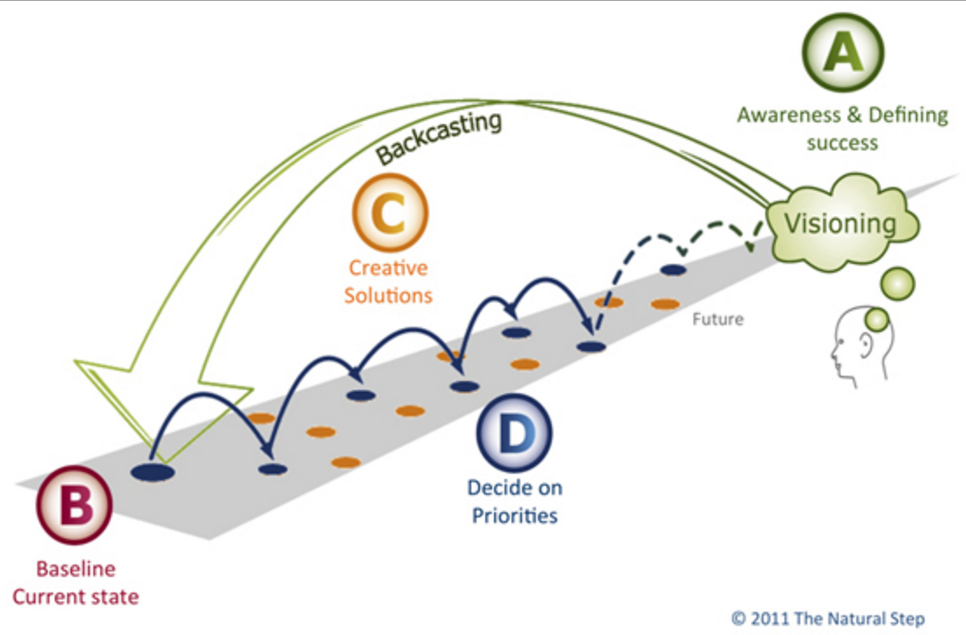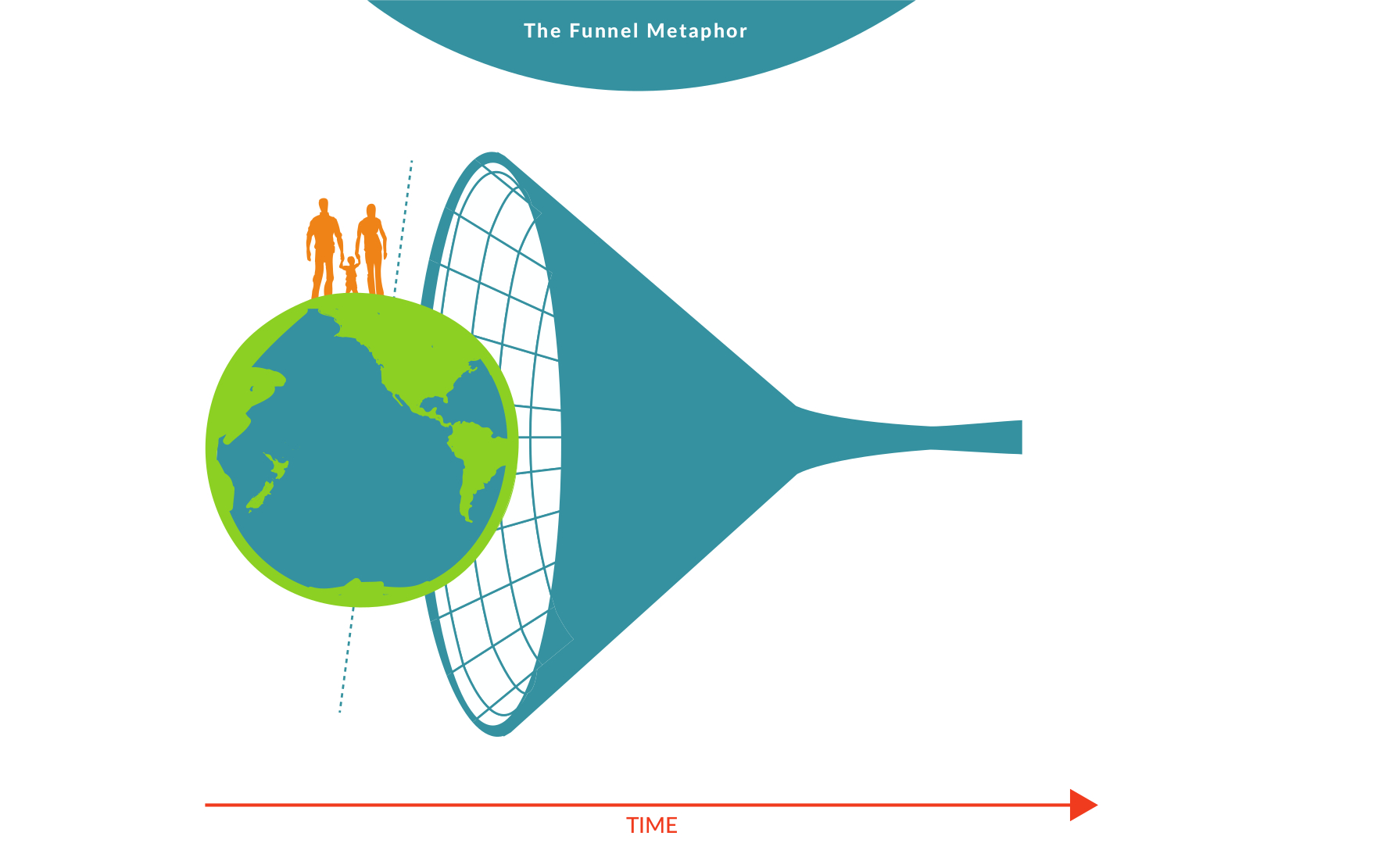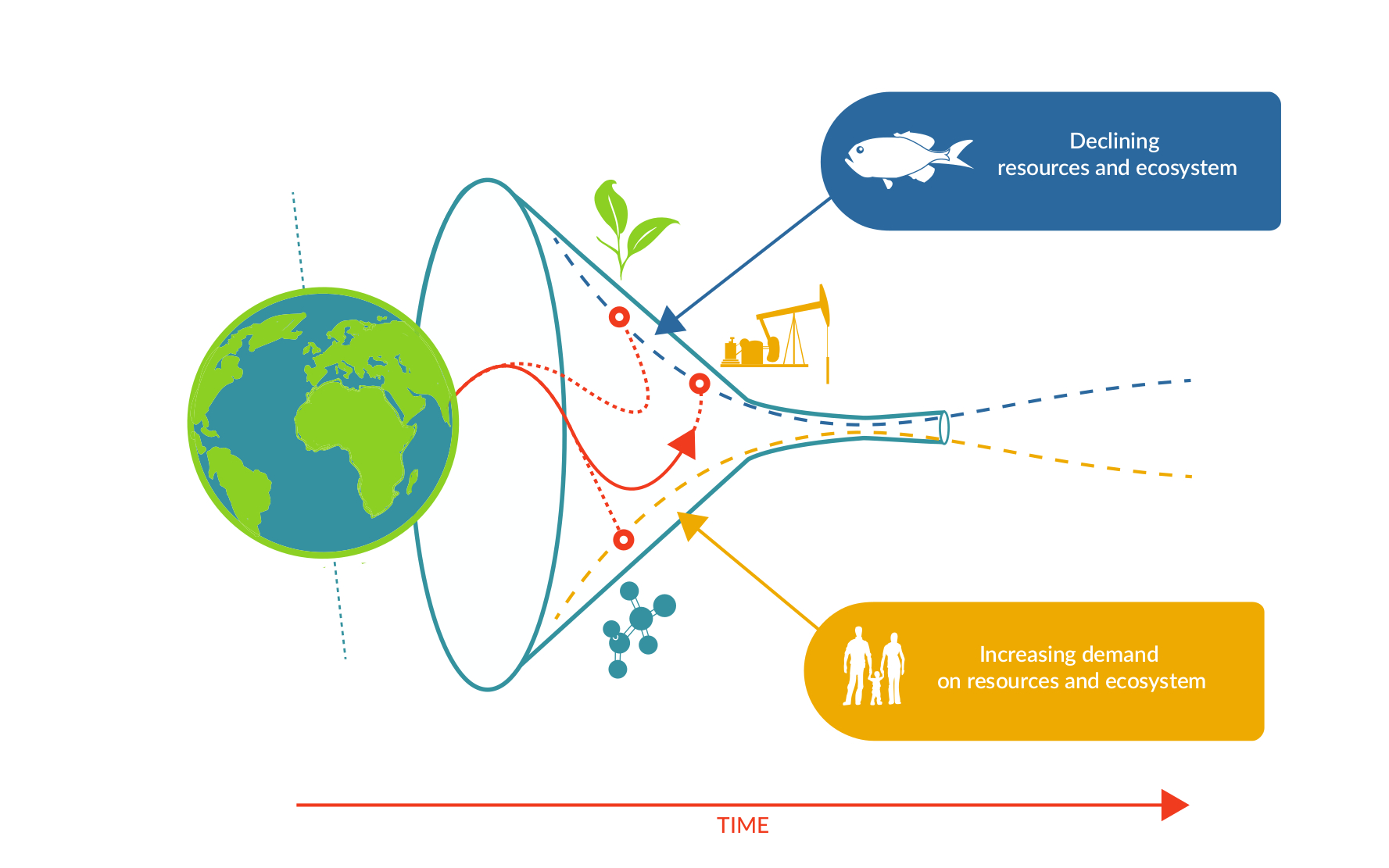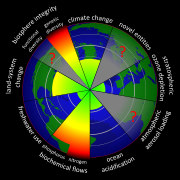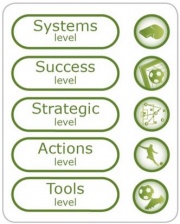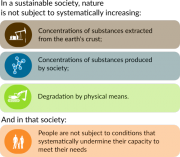Sustainable futures/DTLF/Learning
MICRO COURSE : Designing the transition to a living future
Good strategy uses the tension created between two points - a current state and a desired future - to discover and agree creative ways of moving from one to the other. In this micro course you’ll learn some powerful tools to assess and benchmark a baseline position of current performance. The focus is on finding ways to engage others in the process that will also raise their understanding of the issues, and enable them to begin seeing opportunities of sustainable practices.
Video Signpost
Sessions
- Understanding the challenge
- Identifying trends and drivers of change
- Assets inventory - setting a baseline
- Identifying sustainability impacts - positive and negative
- Evaluating key relationships
Contents
Session 1: Understanding the challenge
Objectives
- Learn about the Funnel model to understand and conceptualise the shift from unsustainability to sustainability and a restorative future.
- Understand that we have planetary boundaries.
- Our Ecological footprint as a measure of impact
- Our Handprint as a measure of restorative value
Video Signpost
|
|
|
A free content video streamed from Vimeo
Avoid deletion: Upload a free format version of this video to the Commons |
Introduction
Ultimately, we need to design a future for our society that is aligned with the principles for life. By understanding the current unsustainable paradigm and the design flaws that perpetuate it, we can begin to envision a future that is designed for life to flourish and focus our attention on allowing that future to emerge. This section will help you understand the current paradigm, the impacts that are arising, and how to identify them so that we can understand the ‘gap’ between the current situation (baseline) and the desired future. This gap reveals a creative tension that can be used to identify and prioritise solutions to reach the desired vision of the future.
Referring the Natural Step’s ABCD model, this Micro Course is focused on Step B; whereas the The inspiring challenge of sustainable development Micro Course concentrated on the Awareness part of Step A. The Strategic Planning for Success Micro Course will look at the Vision part of Step A, and Micro Course 4 will look Steps C and D.
The Funnel Model
The Funnel
The Funnel is a simple metaphor that represents the transition from a society that is unsustainable to one that is sustainable and, ultimately, restorative. The walls of the Funnel are currently closing because of the way we’re living. The model reflects that there is less and less of the things we need to ensure well-being and prosperity for people over the long-term. Yet, there is continually increasing demand for those things through population growth and agendas pursuing traditional economic development. From an ecological and economic perspective, the Funnel represents issues like the declining amounts of natural materials, minerals, scarce metals and healthy ecosystems available to meet our needs. Globally, the health of soils, seas, rivers, lakes, forests and air is in decline because of pollution, over-exploitation and over-use. And with population numbers growing, the stress placed on these systems is increasing. From a social perspective, the Funnel represents issues like declining levels of trust, influence, equality, diversity and meaning. The walls of the Funnel reflect the many trends of unsustainable systems that are visible all over the world. For example, increasing prices for materials, energy, land and water; declining water quality and availability; and declining environmental quality. Declining levels of trust that people have in business and government. At the same time, there are more and more people on the planet seeking first world living standards. The pressure for economic growth is relentless, and as long as that growth uses the same approach, the walls of the Funnel continue to close. How do these issues they affect our society, and the economy? What risks does this funnel-like dynamic create? And, what opportunities does it create for those communities and organisations that understand it? What must change to achieve a viable future? The key point of the Funnel is that until we redesign the way society is governed at a global level (primarily the economic governance model), the walls of the funnel will continue to get closer together with inevitable risks for businesses and people.
Sustainable versus restorative paradigm
The funnel metaphor shows the transition to a paradigm where the walls of the funnel run parallel to each other and then begin to diverge. This represents the transition towards a sustainable and ultimately a restorative (or regenerative) future.
Living Buildings and Interface - examples of the commitment to a restorative future
Reference
- The Great Squeeze - https://www.youtube.com/watch?v=SYzjRDtFxuo Retrieved on 27th January 2015)
- Net Positive- the next step for sustainability pioneers - Retrieved on 27th January 2015 from - http://www.forumforthefuture.org/blog/net-positive-next-step-sustainability-pioneers
- Living Building Challenge - Philosophy: Retrieved on 27th January 2015 from https://ilbi.org/about/About-Docs/handouts-docs/all-in-one-handout
- Interface case study: Retrieved on 27th January 2015 from http://www.naturalstep.org/sites/all/files/case_study_interface.pdf
Session 2: Identifying trends and drivers of change
Objectives
- Identify what’s behind the trends affecting your business/organisation/community
- Analyse the likely outcomes from these trends
Video Signpost
Introduction
All trends have drivers of change behind them. Identifying these can provide insight into how to best position to maximise the opportunity to align to a better future.
Planetary Boundaries
The walls of the funnel reflect social and ecological boundaries. Some work by the Stockholm Resilience Centre has identified nine important boundaries that reflect the impacts from the current unsustainable paradigm.
Ecological Footprint and Handprint
Emerging measurements of human impacts on the planet are gaining mainstream credibility. The Ecological Footprint has been developed by an international coalition called the Global Footprint Network as a measure of our use of the planet’s biocapacity. The Ecological Handprint measure seeks to build upon the Footprint measure and reframe the concept of sustainability by looking not just at ecological impacts but also ensuring sustenance for those in need.
Ecological Footprint
The ‘ecological footprint’ of humanity is gaining attention as way of measuring the amount of resources we consume and the waste we produce against the planet’s ability to produce those resources and ‘digest’ our waste. Currently, every year we are exceeding the planet’s ‘biocapacity’ to perform these functions by about 50%. The ecological footprint calls this an ‘overshoot’. In 2014, overshoot day - that is the day we used up 100% of the planet’s biocapacity - fell on August 19th.
Ecological Handprint
Ecological Handprints bring a social dimension to the issue of measuring our Footprint and recognise the need for people’s needs to be met as part of the sustainability agenda. This concept suggests that we can achieve a high level of human development without compromising the ecological systems upon which all life depends.
References
- Planetary Boundaries paper: Retrieved on 27th January 2015 from http://www.ecologyandsociety.org/vol14/iss2/art32/
- Stockholm Resilience Centre website: Retrieved on 27th January 2015 from http://www.stockholmresilience.org/research/researchnews/tippingtowardstheunknown/thenineplanetaryboundaries.4.1fe8f33123572b59ab80007039.html
- Global Footprint Network overview: Retrieved on 27th January 2015 from http://www.footprintnetwork.org/en/index.php/GFN/page/footprint_basics_overview/
- Earth Overshoot Day: Retrieved on 27th January 2015 from http://www.footprintnetwork.org/en/index.php/GFN/page/earth_overshoot_day/
- Rockström, J., W. Steffen, K. Noone, Å. Persson, F. S. Chapin, III, E. Lambin, T. M. Lenton, M. Scheffer, C. Folke, H. Schellnhuber, B. Nykvist, C. A. De Wit, T. Hughes, S. van der Leeuw, H. Rodhe, S. Sörlin, P. K. Snyder, R. Costanza, U. Svedin, M. Falkenmark, L. Karlberg, R. W. Corell, V. J. Fabry, J. Hansen, B. Walker, D. Liverman, K. Richardson, P. Crutzen, and J. Foley. 2009. Planetary boundaries:exploring the safe operating space for humanity. Ecology and Society 14(2): 32. Retrieved on 28th January 2015 from http://www.ecologyandsociety.org/vol14/iss2/art32/
Additional resources
Journal article in Ecology and Society -Robèrt, K.-H., G. I. Broman, and G. Basile. 2013. Analyzing the concept of planetary boundaries from a strategic sustainability perspective: how does humanity avoid tipping the planet? Ecology and Society 18(2): 5.: Retrieved on 28th January 2015 from http://www.ecologyandsociety.org/vol18/iss2/art5/
Session 3: Baseline: Assets and platforms
Objectives
- Identify existing assets and platforms that can support new initiatives
- Understand common organisational management systems that provide structure and accountability
Video Signpost
Setting a baseline - current sustainability assets
Many people in business are surprised by how many good things they are already doing: energy efficiency initiatives, recycling, waste diversion, community contributions and many more. And it’s the same with communities and councils. The truth is, over the last years much has been achieved to reduce the impact of our activities through well-designed initiatives.
For any organisation, there is great value in understanding the full range of initiatives in place and why they have been successful. What have teams learnt about what works, and what doesn’t work to engage people and change behaviours? What possibilities do the successful initiatives already in place create for further progress?
Setting a baseline - organisational environmental management systems
Business is no stranger to formal management systems that establish processes and systems to ensure compliance with regulations and industry expectations. In the sustainability area, the ISO 14001 family of standards is the most common and recognised standard that provides management systems for environmental performance. The ISO 26000 standard provides guidance on how businesses and organisations can operate in a socially responsible way.
Environmental management systems like these are common and certainly contribute to an organisation’s improved performance. To gain a little more overview understanding, have a look at the Wikipedia page on environmental management systems.
Sustainable product certification and standards
Around the world there are literally hundreds of different sustainable product certification and standards. Some apply at a national level - like New Zealand’s Qualmark certification for the tourism and visitor industry; others apply at a regional level - like the Nordic Swan Ecolabel in Scandinavian countries; whilst others are recognised internationally like the Fair Trade certification and FSC certification (Forest Stewardship Council).
Sustainable product certifications and standards are increasingly used to demonstrate legitimacy and enhance the appeal of products to consumers seeking to buy ethically produced and more sustainable, responsible products. Of course, the strength of the product claim depends entirely on how robust the standard is, and how easy - or difficult - it is to achieve. More recently, businesses that want to seriously demonstrate the sustainability credentials of their product have used the EPD, or Environmental Product Declaration, process to provide full transparency about the product using a Life Cycle Assessment approach.
References
- ISO 14000 - Environmental management http://www.iso.org/iso/home/standards/management-standards/iso14000.htm - Retrieved 15/03/2015
- ISO 26000 - Social responsibility http://www.iso.org/iso/home/standards/iso26000.htm - Retrieved 15/03/2015
- Environmental management system on Wikipedia http://en.wikipedia.org/wiki/Environmental_management_system - Retrieved 15/03/2015
- New Zealand Qualmark Certification http://www.qualmark.co.nz/ - Retrieved 15/03/2015
- Nordic Swan Ecolabel http://www.nordic-ecolabel.org/ - Retrieved 15/03/2015
- Fair Trade certificationhttp://www.fairtrade.net/ - Retrieved 15/03/2015
- FSC certification https://ic.fsc.org/ - Retrieved 15/03/2015
- Interface Environmental Product Declaration http://www.interface.com/US/en-US/about?cmsContent=/carpet/Interface-EPDs.html Retrieved 15/03/2015
Additional Resources
- The B Impact Assessment tool. Retrieved on 28th January 2015 from http://bimpactassessment.net/
- McDonald, J. P. 2005. Strategic Sustainable Development using the ISO14000 Standard. Journal of Cleaner Production 13 (2005), 631 - 643. Retrieved on 28th January 2015 from http://www.thenaturalstep.org/sites/all/files/ISO14001-TNS-FINAL.pdf.
- A 5 minute read which is fun…http://youhavetoomuchshit.com/ Retrieved 29th January 2015
Session 4: Sustainability impacts assessment
Objectives
- Identify how an organisation, project or community is currently contributing to unsustainable impacts
- Begin to articulate the challenges that need to be addressed in strategic planning to move towards sustainable practices
Video Signpost
Introduction
As we learnt in the The inspiring challenge of sustainable development micro course Session 3 From the Holocene to the Anthropocene the four system conditions, or sustainability principles, defined by the Natural Step in its Framework for Strategic Sustainable Development provide a robust definition of sustainability. These four principles can be used as a tool to audit a business, community or even a project to identify all the ways in which it currently contributes aspects of unsustainable practices.
This session will lead you through a process to carry out a sustainability impacts assessment using the four sustainability principles. The results of the assessment can then be used to create strategic goals to drive future decision-making.
Using the Natural Step’s four system conditions for a sustainability impact assessment
An important first step before carrying out a sustainability impacts assessment is to define the scope of what you are assessing. A useful way to do this is to draw a map of the system (be it an organisation, community, project or a whole value chain) that you are assessing. The map can show the flow of materials, energy, organisations, people and money involved.
Using an organisation as an example, the process involves asking a series of questions:
- In what ways is the organisation contributing to the systematic accumulation in nature and natural systems of materials that have been extracted from the earth’s crust?
- In what ways is the organisation contributing to the systematic accumulation in nature and natural systems of synthetic and man-made materials produced by society?
- In what ways is the organisation contributing to the systematic damage, degradation and destruction of natural systems by physical means?
- In what ways is the organisation contributing to creating conditions that undermine people’s ability to meet their needs?
Prioritising identified sustainability impacts
It’s useful and valuable to prioritise the impacts that you identify from the impacts assessment exercise. This will help identify which impacts are more significant and should be addressed as a priority. There is no science to determine what is more or less significant, and some useful guidance is provided on page 11 of the Planning for Sustainability guide mentioned above. The matrix tool below is also a useful way of evaluating the priority of different impacts.
Articulating a set of clear sustainability challenges
Using the information you will have generated from the impacts assessment and prioritisation exercises, you should be in a position to articulate a set of clear sustainability challenges. These challenges reflect the current situation. Often they can seem a bit overwhelming. You might think about it as taking a long look in the mirror and honestly laying out all the things that will need to change to achieve sustainability.
As an example of a set of challenges… here’s a list that a land development company produced after going through the process above.
- Our business is highly dependent on the degradation of ecologically and agriculturally productive land for development
- We are highly dependent on the dispersive use of hydrocarbons as a fuel and raw material
- We are dependent on an economic and physical system that systematically converts virgin material into unusable waste in both the short and long term
- We are dependent on using materials that have toxic effects in the ecosystem and on biological organisms
- We support and are dependent on an unsustainable supply chain and business model
As we’ll see in Creating Sustainable Futures Strategic Planning for Success micro course, these challenges were effectively addressed by setting strategic goals that addressed each of the issues, and the company in question has become a pioneering, award-winning sustainable business leader.
You might think of this challenge setting process as being like an alcoholic or drug addict seeking help. Until they are prepared to admit their illness and face up to it, it is almost impossible to provide effective, long-lasting therapy and treatment to cure them.
References
- Planning for Sustainability: A Starter Guide, http://www.naturalstep.org/sites/all/files/TNS_NZ_Sustainability_Planning%20Guide%20Print.pdf , retrieved 16/03/2015
Session 5: Evaluating important relationships
Objectives
- Understand the importance of recognising how others can help or hinder your sustainability goals
- Learn how to identify potential partners and collaborators that can help address complex sustainability challenges
Video Signpost
Introduction
Many sustainability issues are very complex to solve and require a lot of people, or organisations, to contribute to a desired solution. Many people, particularly in businesses or government organisations, also have strong vested interests in maintaining the status quo. Identifying, evaluating and understanding these important relationships can significantly affect the success of new initiatives.
Identifying relationships that will influence success
Pursuing bold initiatives that change the way things are done to achieve sustainable outcomes inevitably requires a big effort, with lots of people working together. Even within a single organisation, it is likely to require different departments and teams to work together and change the way things have been done. More often than not, these initiatives require working in new ways with suppliers, communities and new partners to achieve success for ambitious goals.
Important relationships and stakeholders are those that will play a significant part in bringing about the success of the initiative. Typically, the have something to lose or gain from the initiative. In a community setting it may be people from local government, politicians or community groups. In a business context, it may be executives, other team members, suppliers, new partners or even customers.
The importance of collaboration
Because of the complexity of sustainability issues, and the need for a range of players to contribute to success, collaboration is emerging as perhaps the most important skill for leaders and decision-makers. Establishing shared interests in solving vexing problems, and working with large multi-stakeholder groups is often difficult and requires a new type approach, particularly in the business world.
References
- Planning for Sustainability: A Starter Guide, http://www.naturalstep.org/sites/all/files/TNS_NZ_Sustainability_Planning%20Guide%20Print.pdf, retrieved on the 16/03/2015
- Unilever's Paul Polman: challenging the corporate status quo, http://www.theguardian.com/sustainable-business/paul-polman-unilever-sustainable-living-plan, retrieved on the 16/03/2015

